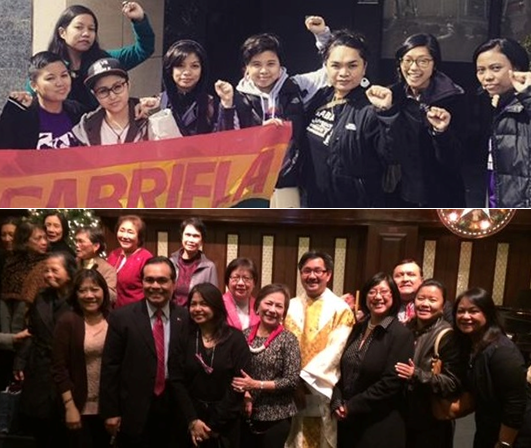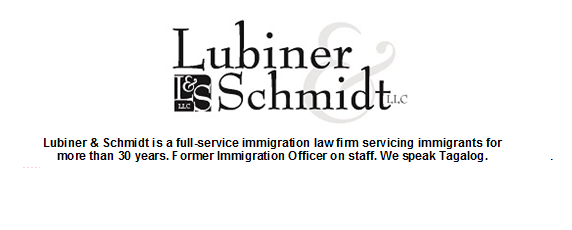5 leaders share thoughts on organizing in a diverse, at times discordant, FilAm community (Part 1)

There are about 300 community organizations in the New York metropolitan area, from militant activist (top) to faith-based groups, such as the Simbang Gabi.
The five personalities in this forum were chosen for the long history and rich experience they’ve had with community organizing.
Together, community leaders Ledy Almadin, Lumen Castaneda, Yves Nibungco, Candice Sering and Vivian Talambiras-Cruz, have about 20 organizations among them that they may have started from the ground up or nurtured to strength to become pillars of the FilAm community in the New York metropolitan area. They are the movers and innovators who keep the community vibrant by being actively engaged and urging their followers to do the same.
From the ballroom to the boardroom, LEDY ALMADIN is a visible personality. She is incoming president of Philippine-American Friendship Committee (PAFCOM) as well as treasurer at the Philippine American Chamber of Commerce in New York (PACC), founded in 1920. She is concurrently the president of the Sta. Cruz Laguna Association, a social club for FilAms who come from the Philippine province of Laguna.
LUMEN CASTANEDA, a retired public school teacher, is the founder of the United Federation of Fil-Am Educators or UNIFFIED, which has chapters in about a dozen states. At the Pan American Concerned Citizens Action League (PACCAL), she is the president of the 23-year-old organization based in Jersey City. Castaneda has a more low-key role at PAFCOM, where she is the treasurer, but her dynamic presence is very much felt in meetings and community engagements.
YVES NIBUNGCO strikes a quiet but forceful presence in the progressive youth movement. He is currently founding chairperson of Anakbayan USA after serving as secretary general for three years of the regional Anakbayan New Jersey. He is concurrently an organizer of the Filipino Immigrant and Workers Organizing Project and the Northeast regional coordinator for the Kapit Bisig Kabataan Network.
Cultural worker and grassroots organizer CANDICE SERING is currently serving her second year as the chairperson of GABRIELA New York, as well as a member of the National Council of GABRIELA USA.
VIVIAN TALAMBIRAS-CRUZ is member of the board of the Assumption Alumnae Association Abroad, where she was two-term president from 2001 to 2007. She is chairperson of the Coalition of Philippine Alumni Association since 2001. She serves as adviser of the Philippine Cultural Society of the UN, but has declined a titled position because, she said, “I thought I could serve better by being on the sideline.” She is one of the movers behind the Simbang Gabi, the Homecoming sa Konsulado, and the Philippine Consulate’s Build a Shelter Project fundraiser for the families of Typhoon Haiyan. .
In this forum, they share their views on the pitfalls of organizing as well as best practices they have learned along the way. Their responses to five questions provide an insight into their leadership styles and their vision-led strategies to inspire their members to become leaders of the future.
Would you rather have few members who are motivated or many members who are mostly passive and indifferent?
 Ledy Almadin: The number of members depends on the mission of the organization. It should have the right number of members to work on the mission. I would rather have motivated members. When everyone is motivated, the group is more productive and more creative. When the group is mostly passive, many times there’s only a couple of people who end up doing the job. There’s not much growth and people get burned out.
Ledy Almadin: The number of members depends on the mission of the organization. It should have the right number of members to work on the mission. I would rather have motivated members. When everyone is motivated, the group is more productive and more creative. When the group is mostly passive, many times there’s only a couple of people who end up doing the job. There’s not much growth and people get burned out.
Lumen Castaneda: Leading an organization is a tough job. A leader has to have  compassion, patience, discipline, control and love for the organization. Sometimes, having a few members who are committed to the cause is better than having a lot of members for the sake of membership. With a few members, the task becomes easier because there are a few opinions to contend with, whereas, if there are too many members arguing this and that, it takes a longer time to decide on an issue. Having a few members resolves an issue smoothly since each member understands the importance of what has to be tackled on in the space of time allotted.
compassion, patience, discipline, control and love for the organization. Sometimes, having a few members who are committed to the cause is better than having a lot of members for the sake of membership. With a few members, the task becomes easier because there are a few opinions to contend with, whereas, if there are too many members arguing this and that, it takes a longer time to decide on an issue. Having a few members resolves an issue smoothly since each member understands the importance of what has to be tackled on in the space of time allotted.
 Yves Nibungco: Radically changing society is a mass undertaking; it requires a mass movement. To achieve this, it does not only prefer but actually require a large number of membership that are motivated. But given the choice, I’ll pick a handful of committed and passionate individuals. A handful of committed and passionate individuals can help inspire many others to be as committed. But I do recognize that not everyone is immediately a hardcore organizer. It is our role to inspire passion and commitment from the rest of the membership and the community, so that they too can become leaders.
Yves Nibungco: Radically changing society is a mass undertaking; it requires a mass movement. To achieve this, it does not only prefer but actually require a large number of membership that are motivated. But given the choice, I’ll pick a handful of committed and passionate individuals. A handful of committed and passionate individuals can help inspire many others to be as committed. But I do recognize that not everyone is immediately a hardcore organizer. It is our role to inspire passion and commitment from the rest of the membership and the community, so that they too can become leaders.
Candice Sering: With GABRIELA USA, it is not really an option to be comprised of a  membership that is largely passive and indifferent. An organization with few members who are motivated and active versus many members who are mostly passive or indifferent is more likely to make an impact with regard to successful campaigns, educational forums and community events. When you start small and powerful, with engaged members, your chances of growing are better than trying to gather indifferent members who are not active to participate more. It is also important to assess your organization’s composition regularly.
membership that is largely passive and indifferent. An organization with few members who are motivated and active versus many members who are mostly passive or indifferent is more likely to make an impact with regard to successful campaigns, educational forums and community events. When you start small and powerful, with engaged members, your chances of growing are better than trying to gather indifferent members who are not active to participate more. It is also important to assess your organization’s composition regularly.
 Vivian Talambiras-Cruz: The answer is obvious. I would rather have a few motivated members. Those few select individuals who are highly motivated will see to it that things get accomplished. When there is a goal to achieve, doers will have more focus to get things done. Passive members will likely slow down the process. From experience, working with a few but motivated and dedicated members have made more positive results.
Vivian Talambiras-Cruz: The answer is obvious. I would rather have a few motivated members. Those few select individuals who are highly motivated will see to it that things get accomplished. When there is a goal to achieve, doers will have more focus to get things done. Passive members will likely slow down the process. From experience, working with a few but motivated and dedicated members have made more positive results.
NEXT: Organizations’ ‘best practices’ from educating members to raffles, potluck meetings
![]()












[…] 5 leaders share thoughts on organizing in a diverse, at times discordant, FilAm community (Part 1) […]